In an era where technological innovations are fast reshaping the economic landscape, IT leaders continuously look for methods to streamline operations, cut costs, and increase productivity. IT outsourcing services emerge as an invaluable tool in this endeavour, optimizing resource allocation and tapping into a worldwide pool of experience and technical innovation.
In this guide, we explore the world of IT outsourcing, including its different types, its many advantages, and the factors to consider when choosing a partner. Whether looking into managed services, cloud solutions, or other options, understanding the range of IT outsourcing services is crucial for maximizing your company’s IT strategy.
As we dive into the complexities of IT outsourcing, we’ll discuss how leaders can make well-informed choices that align with their business objectives and lead to lasting success.
What are IT Outsourcing Services?
IT outsourcing services are the process of employing external service providers to undertake specific IT operations that would otherwise be conducted in-house. The approach enables firms to access specialist expertise, cutting-edge technology, and round-the-clock assistance while remaining focused on their core capabilities.
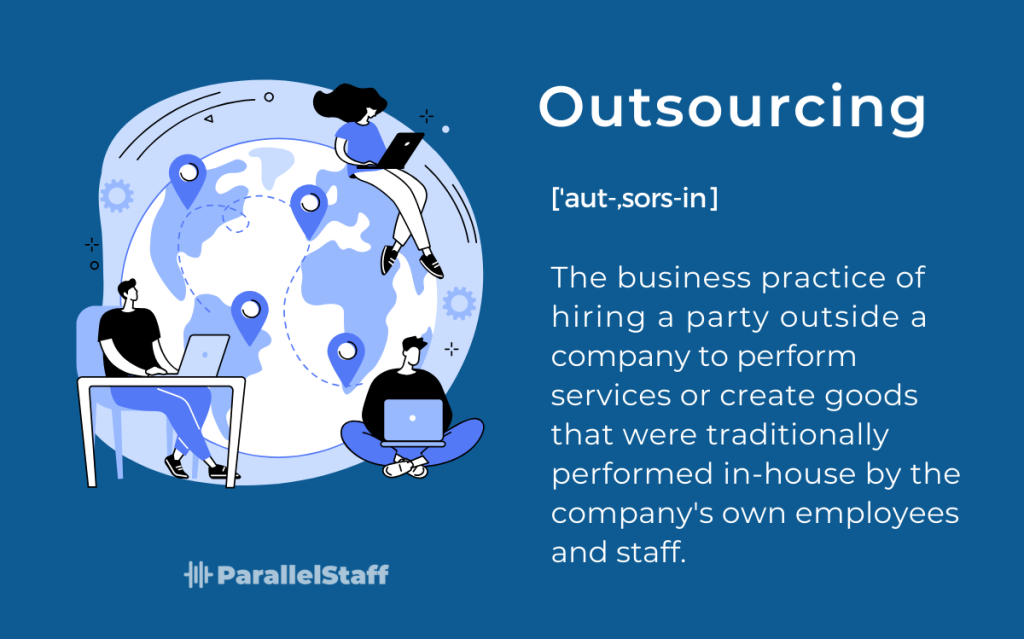
Outsourcing provides various services, including software development, cloud computing, data analytics, and cybersecurity.
Key Reasons for Outsourcing IT
Several compelling reasons drive businesses to consider IT outsourcing, including:
Cost Efficiency
Outsourcing is an attractive choice because it has the potential to reduce operational and labor costs considerably. This cost efficiency is due to the ability to capitalize on economies of scale and leverage outsourced providers’ cost structures. Businesses can convert fixed IT costs into variable costs via outsourcing, allowing them to allocate their budget more efficiently and pay for services only as they are needed. This concept especially appeals to organizations that want to optimize spending and direct funds toward growth-oriented projects.
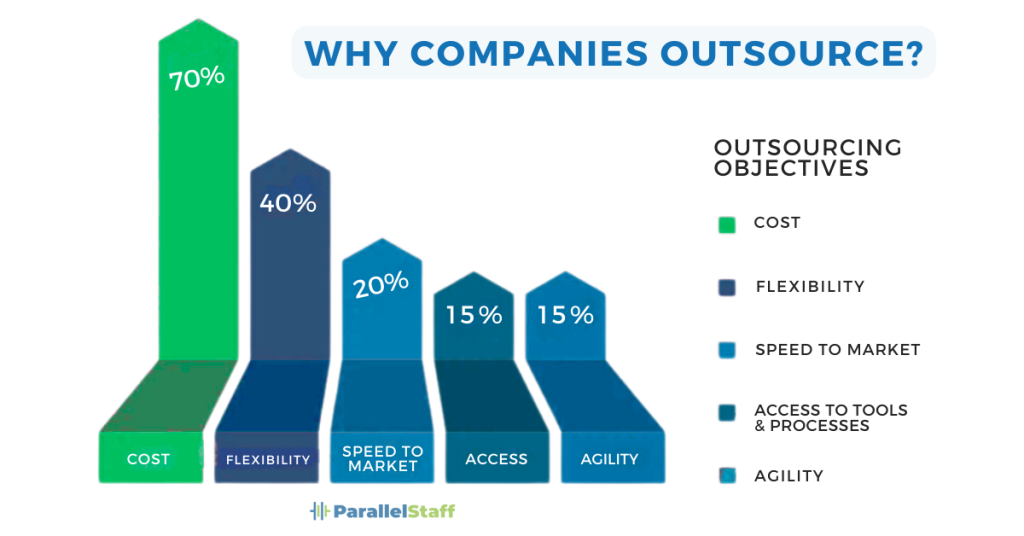
Access to Specialized Skills
One of the most compelling reasons to outsource IT is the access to specific skills and knowledge. The technology environment is broad and fast-changing, making it difficult for a single firm to cover all areas of expertise internally.
Outsourcing partners often concentrate on specific areas of the IT ecosystem and invest considerably in training and certifications. This concentration allows them to provide extensive knowledge and up-to-date information, ranging from cutting-edge cybersecurity measures to the most recent cloud infrastructure and data analysis tools. For organizations, this means accessing specialist skills on demand, putting them ahead of the competition and encouraging innovation.
Focus on Core Business Functions
Outsourcing IT activities enables firms to refocus their internal resources on core skills that drive development and value generation. In today’s competitive business world, firms must be adaptable and innovative, always upgrading their products, services, and customer experiences.
By delegating technical and operational IT tasks to external experts, firms can free up their in-house teams to focus on strategic projects corresponding to long-term business objectives. This strategic reallocation of resources improves operational efficiency and the company’s ability to innovate and respond to market developments.
Scalability and Flexibility
Because of today’s dynamic business environment, businesses must be extremely adaptable, scaling operations up or down in response to market needs, seasonal peaks, or growth phases. IT outsourcing offers unparalleled scalability and flexibility, allowing organizations to instantly alter their IT capabilities and capacity without needing significant capital investments or long-term commitments.
Outsourcing partners can provide scalable solutions that grow with your organization, ensuring that IT services align with current requirements. This adaptability is invaluable for firms that need to pivot rapidly, enter new markets, or scale operations efficiently.
Types of IT Outsourcing
There are several different types of IT outsourcing options, depending on the needs of the business or project.
Managed IT Services
Managed IT Services involve outsourcing the obligation to maintain and anticipate the demand for a variety of processes and tasks to improve operations and reduce costs. This model is especially useful for firms that want to outsource their entire IT operations or specialized pieces, such as cybersecurity or network management.
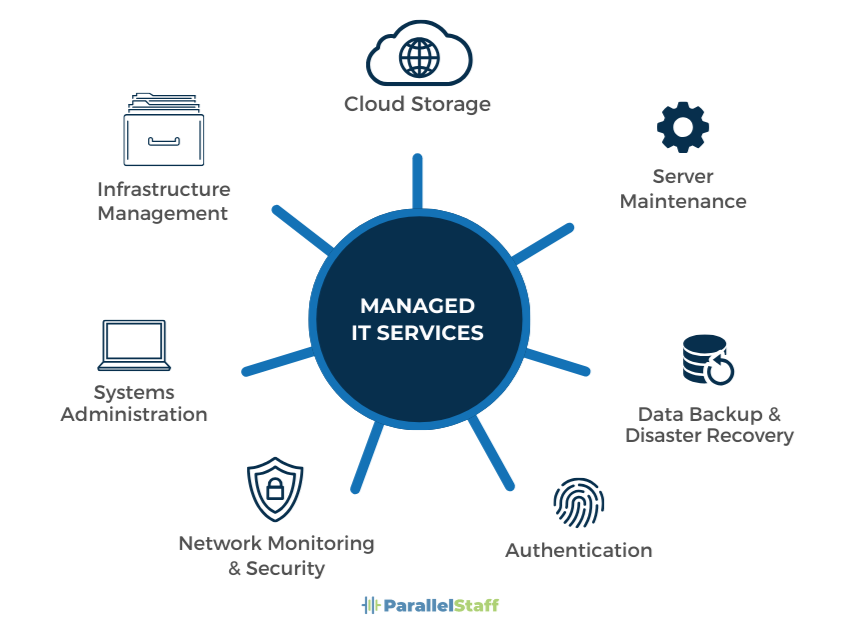
Cloud-Based IT Services
The transition to cloud computing has resulted in the proliferation of cloud-based IT services, in which enterprises use cloud platforms for storage, applications, and infrastructure. This architecture provides greater flexibility, scalability, and cost reductions than typical IT installations.
Leading services include Amazon Web Services (AWS), Microsoft Azure, and Google Cloud Platform.
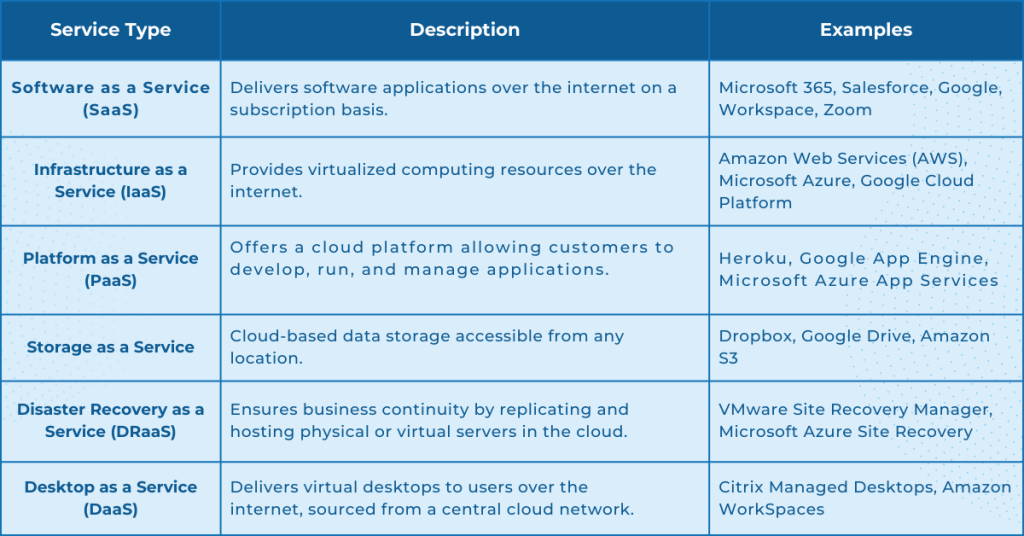
Data Center Outsourcing
Outsourcing data center operations can help firms manage and store crucial data more effectively. Providers provide a solid infrastructure that ensures data security, backup, and accessibility.
Data center outsourcing offers significant benefits, including reduced capital expenses for companies. By outsourcing, businesses avoid the costs of acquiring buildings, redundant infrastructure, cooling and electrical systems, security features, and hiring and maintaining a facilities team.
The data center provider bears these costs, leading to tenants paying predictable monthly fees. Moreover, outsourcing enhances connectivity options, with many providers offering links to major cloud services and multiple fiber providers.
Network Infrastructure Outsourcing
This includes outsourcing network management and operations. It is critical for organizations that rely primarily on a robust and secure network infrastructure to run their daily operations.
This service encompasses many tasks, from network planning, implementation, and maintenance to continuous monitoring and security management.
Customer/End User IT Services
These services, which focus on improving the customer experience, include a help desk, support services, and application administration to assure end-user support and satisfaction.
Furthermore, outsourcing Customer/End User IT Services allows firms to divert internal resources to essential activities, hence boosting development and innovation. It encapsulates a partnership that goes beyond transactional encounters, striving for a profound commitment to improving the customer experience.
IT Software and Application Outsourcing
Software and application outsourcing covers the development, maintenance, and updating of business applications. This enables businesses to keep up with the latest technologies without needing in-house development teams.
Pros and Cons of IT Outsourcing
Outsourcing IT activities can provide transformative benefits to a firm, but it also presents a set of challenges. Understanding both sides of the coin is critical for making sound decisions.
Advantages of IT Outsourcing
- Cost Savings
One of the most obvious advantages of IT outsourcing is a large decrease in operating and capital costs. Outsourcing enables businesses to pay for IT services only as needed, minimizing the need for ongoing investments in IT infrastructure and personnel. This method reduces costs, allowing capital to be redirected to other strategic parts of the firm.
- Expertise and Innovation
Another significant advantage is having access to cutting-edge technology and specialized talents. IT outsourcing organizations invest significantly in keeping a team with superior skills and a current understanding of the newest technical trends.
This ensures that organizations benefit from cutting-edge solutions and innovative approaches to IT difficulties, resulting in increased productivity and competitiveness.
- Risk Management
Outsourcing IT services also entails relinquishing risk management to the provider. This consists of many risks associated with compliance, security, and operations.
Outsourcing firms have the skills and structures to effectively minimize these risks, giving businesses an extra layer of protection in an ever-changing threat landscape.
- Focus on Business Strategy
Offloading IT operations to an outside supplier allows firms to refocus their internal resources on core business strategy and objectives. This shift allows for a more effective allocation of resources to sectors with the best returns, promoting growth and innovation.
Disadvantages of IT Outsourcing
- Communication Challenges
One of the most pressing issues in IT outsourcing is overcoming time zone differences, language obstacles, and cultural idiosyncrasies. These variables might cause misunderstandings, delays in project timeframes, and difficulties in creating a smooth workflow between the company and its outsourcing partner.
- Potential Loss of Control
Outsourcing IT tasks typically entails giving up control over specific processes and systems. This loss of direct management can be unsettling for firms that are used to managing all parts of their IT infrastructure in-house. The organization and the outsourcing provider must maintain a strong relationship of trust to achieve matched aims and quality deliverables.
- Security Risks
While outsourcing can assist in managing risks, it also raises data security and privacy issues, mainly when third-party providers handle sensitive information. Establishing explicit contracts, conducting regular audits, and selecting trustworthy vendors with solid security measures are all critical steps in limiting risks.
Choosing the Right IT Outsourcing Services
Selecting the most suitable IT outsourcing services is crucial for maximizing the benefits while minimizing the risks associated with outsourcing.
Things to Keep in Mind when Choosing IT Outsourcing Services
There are several factors to consider when choosing an IT outsourcing service partner
Alignment with Business Goals
When selecting IT outsourcing services, alignment with corporate objectives is critical. This means finding a partner with a solid track record in your industry and a thorough understanding of your company procedures and issues.
For example, a financial services organization might benefit from collaborating with an IT outsourcing company specializing in fintech solutions, providing technical experience and regulatory compliance.
Expertise and Reputation
Expertise and reputation are crucial. It helps to assess potential partners’ competencies in the specific areas you intend to outsource, such as cloud services, application development, or cybersecurity. Researching their previous projects, client feedback, and industry recognitions might yield significant information.
For example, a company known for its innovative cloud solutions would be a good fit for enterprises wishing to expand their cloud computing capabilities.
Security and Compliance
Security and compliance cannot be understated, particularly in companies that handle sensitive data. Outsourcing firms must meet the highest international security requirements and demonstrate compliance with applicable rules.
A healthcare business, for example, must ensure that its IT outsourcing partner is HIPAA compliant and protects patient data adequately.
Flexibility and Scalability
Flexibility and scalability are vital for responding to corporate development and market changes. A competent outsourcing partner provides scalable services that can be changed to meet your changing business demands.
For example, an e-commerce company experiencing significant expansion would benefit from a partner capable of quickly scaling up services to manage increased web traffic and transactions.
Cost Structure
Understanding the cost structure is also important. It entails looking beyond the initial savings to the overall cost of engagement, including any potential hidden expenses.
For businesses wishing to outsource their IT helpdesk services, comparing pricing models from several providers can indicate which provides the most value in terms of cost, service level agreements, and scalability.
Communication and Collaboration
Communication and teamwork are critical to the success of an outsourcing partnership. Good communication channels and tools are essential for managing projects and quickly addressing difficulties.
A software development company, for example, would profit immensely from an outsourcing partner who practices agile processes and encourages continual communication and collaboration.
Factors Affecting the Cost of IT Outsourcing
Various components typically affect the cost of IT outsourcing.

By carefully evaluating these components and criteria, IT executives may make better decisions when choosing an outsourcing partner. The appropriate cooperation can result in considerable cost savings while improving operational efficiency, innovation, and competitive edge in the marketplace.
Future Trends in IT Outsourcing
As businesses continue to navigate the complexities of digital transformation, the landscape of IT outsourcing is evolving to meet changing demands and emerging challenges. Here are key trends shaping the future of IT outsourcing:
Increased Demand for Cloud Services
As businesses accelerate their migration to the cloud, outsourcing cloud management and services will become increasingly common. To fully benefit from cloud computing, enterprises need partners with expertise in cloud infrastructure, platform management, and cloud security.
Focus on Cybersecurity Outsourcing
As cyber threats become more complex, there is an increasing trend of outsourcing cybersecurity functions. Companies seek IT outsourcing partners specializing in sophisticated threat detection, response capabilities, and compliance management to protect their digital assets.
Rise of Automation and AI
Automation and artificial intelligence (AI) are redefining IT outsourcing. Services that automate mundane processes, AI-powered analytics, and machine learning are in great demand. Outsourcing partners who provide innovative automation and AI solutions will lead the way in delivering value to organizations.
Strategic Partnerships for Innovation
Companies are creating strategic alliances with IT providers in addition to cost-effective standard outsourcing models. These agreements are intended to spur innovation, provide access to new technology, and co-create competitive advantages.
Emphasis on Agile Outsourcing
Agility and flexibility in IT outsourcing agreements are becoming increasingly important. Businesses want partnerships that can quickly respond to market shifts, technological improvements, and altering client needs.
The Rise of Nearshore Outsourcing
Nearshore outsourcing has evolved as an attractive approach, addressing the cost-effectiveness, cultural alignment, and time zone gaps that exist between offshore and onshore outsourcing. This strategy involves working with companies in geographically close proximity to facilitate simpler collaboration and communication.
- Cultural and Linguistic Alignment: Nearshore partners often share similar cultural and linguistic backgrounds, enhancing communication and collaboration.
- Reduced Time Zone Discrepancies: Close geographical proximity means fewer challenges with scheduling meetings or managing real-time collaboration.
- Cost-Effective Solutions: While nearshore outsourcing can be more cost-effective than onshore models, it still offers significant savings over maintaining in-house capabilities.
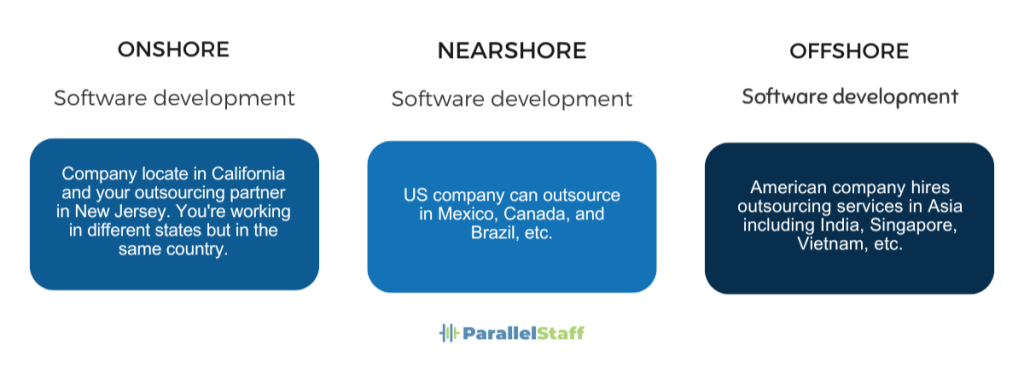
ParallelStaff connects organizations with top-tier IT talent in Latin America, providing a seamless extension of their in-house teams. This collaboration allows businesses to benefit from nearshore advantages such as cultural compatibility, agile collaboration, and access to a large pool of technical experience, all while lowering costs and improving project outcomes.
Essential Tips for Successful IT Outsourcing
As a recap, here are essential tips to ensure the success of your IT outsourcing endeavors.
Tip 1 – Establish Clear Objectives and Expectations
Before beginning an outsourcing collaboration, it is critical to establish clear objectives and expectations. Determine the goals you want to achieve with outsourcing, such as cost savings, access to specialist talents, or scalability. Clearly defined objectives govern the selection of an outsourced partner and serve as standards for monitoring the effectiveness of the outsourcing agreement.
Tip 2 – Choose the Right Outsourcing Model
Choosing the right outsourcing model is crucial for connecting your business needs with the services offered. Consider project scope, required experience, and desired level of control and participation.
Whether it’s a project-based model, a dedicated team, or a completely managed service, the right model will ensure that your outsourcing collaboration improves operational efficiency and helps you achieve your strategic goals.
Tip 3 – Prioritize Communication and Collaboration
Effective communication and collaboration are essential components of every successful outsourcing engagement. Establish clear communication routes and regular check-ins to guarantee alignment and timely resolution of any issues.
Use collaboration tools and technology to ensure seamless interaction and integration between your team and the outsourced partner. A culture of open communication promotes mutual understanding and a healthy working relationship.
Tip 4 – Ensure Data Security and Compliance
Data security and regulatory compliance are primary considerations in IT outsourcing. Conduct rigorous due diligence to ensure that the outsourced partner follows strict security protocols and conforms with applicable data protection rules. Implementing shared security measures and conducting frequent audits will help protect your data and ensure compliance throughout the outsourcing arrangement.
Tip 5 – Focus on Partnership Rather Than Transaction
Approach IT outsourcing as a strategic partnership rather than a transactional one. Look for partners eager to learn about your business, share your values, and are dedicated to your success. A partnership strategy promotes collaboration, innovation, and a joint commitment to attaining company objectives.
Tip 6 – Prepare for Change Management
Integrating an outsourcing partner into your business may include adjustments to processes, technology, and sometimes even culture. Anticipate and manage these changes effectively by preparing your team, setting reasonable expectations, and offering adequate training and support.
Effective change management allows for a smooth transition and leverages the benefits of outsourcing.
Tip 7 – Continuously Monitor and Evaluate Performance
Create measures and KPIs to track the success of your outsourced partner. Regular evaluation of these parameters guarantees that the outsourced arrangement meets your objectives and adds value to your organization.
Be prepared to make changes to meet shifting company needs or handle performance difficulties.
Conclusion: Optimizing IT Outsourcing for Business Success
IT outsourcing has progressed from a cost-cutting strategy to an essential part of business operations, providing access to global talent, cutting-edge technology, and operational efficiency. As the digital landscape evolves, successful firms will increasingly separate themselves from their competition by being able to adapt and successfully harness external resources.
The future of IT outsourcing is positive because of advances in cloud computing, cybersecurity, artificial intelligence, and automation. Strategic alliances, particularly in nearshore outsourcing, combine cost savings, cultural alignment, and operational agility to improve project outcomes and business success greatly.
Platforms such as ParallelStaff reflect this evolution by connecting organizations with the specialized talent required to manage these changes successfully.
Establishing clear objectives, selecting the appropriate outsourcing model, emphasizing security and compliance, and cultivating an open communication culture are all critical milestones on this journey. Furthermore, responding to change, constantly assessing performance, and perceiving your outsourcing provider as a strategic partner are critical to obtaining the required results.
By implementing the best practices suggested in this guide, businesses can negotiate the intricacies of IT outsourcing, forming relationships that will move them forward in an increasingly digital environment.
- What Are the Benefits of Using Python GUI Development? - May 29, 2024
- Mastering the Art of Making an AI: A Practical Guide - May 23, 2024
- Mastering Efficiency: Navigating the World of Microservices Architecture - April 21, 2024






